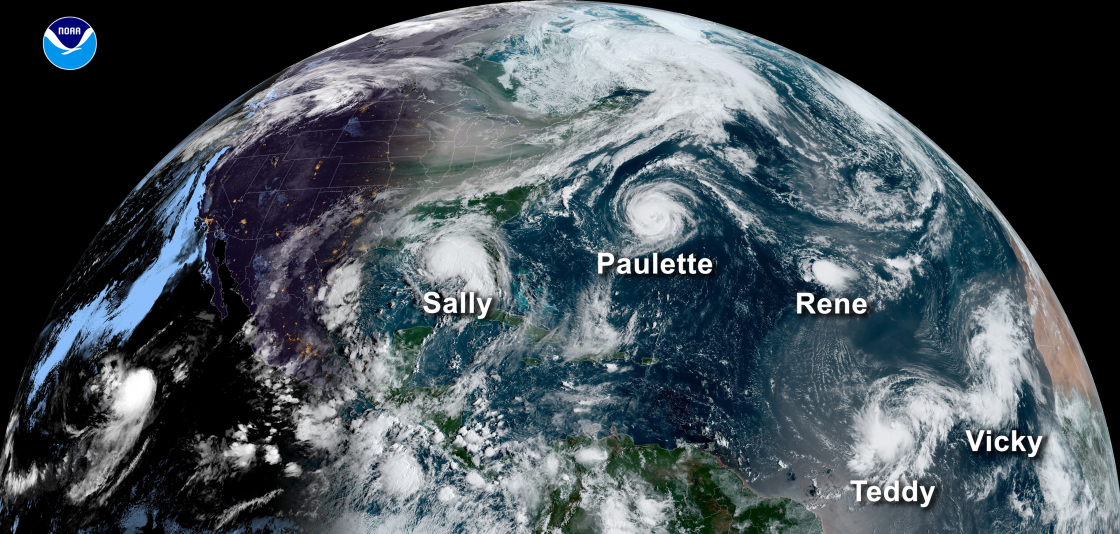(CN) — Government scientists said the 2020 Atlantic hurricane season set several new records as the final week of the official season wound down and experts reflected on the data Tuesday.
“The 2020 Atlantic hurricane season ramped up quickly and broke records across the board,” said Neil Jacobs, acting administrator of the National Oceanic and Atmospheric Administration, in a statement.
North America and the Caribbean contended with a record-breaking 30 named storms, 13 of which became hurricanes and a dozen of which hit the continental U.S, also a new record.
This blew forecasters’ predictions out of the water: it was newsworthy in August when NOAA forecasters had named 25 storms for the first time, predicting that just between seven and 11 would become hurricanes.
This was the second time in history that the Greek alphabet was used when the 21-name Atlantic storm list was exhausted once Tropical Storm Wilfred formed on Sept. 18. A record nine named storms developed from May through July.
Atmospheric scientists attribute the hyperactive hurricane season to the “warm phase” of the Atlantic Multi-Decadal Oscillation (AMO), a long-duration change in the North Atlantic Ocean’s sea surface temperatures. Phases can last between two and four decades at a time. The current warm phase began in 1995.
“As we correctly predicted, an interrelated set of atmospheric and oceanic conditions linked to the warm AMO were again present this year,” said Gerry Bell, lead seasonal hurricane forecaster at NOAA’s Climate Prediction Center, in a statement. “These included warmer-than-average Atlantic sea surface temperatures and a stronger west African monsoon, along with much weaker vertical wind shear and wind patterns coming off of Africa that were more favorable for storm development. These conditions, combined with La Nina, helped make this record-breaking, extremely active hurricane season possible.”
On Sept. 15, the Category 2 storm Hurricane Sally slammed the Alabama coast and Florida Panhandle, bringing what the NOAA said was the “highest observed water levels since Hurricane Katrina in 2005.” The flooding prompted emergency responders to rescue families from homes and even trees by boat.
Louisiana bore the brunt of the hurricane season in the United States. Hurricane Laura reached Lake Charles with 150 mph winds on Aug. 27, submerging much of the west Louisiana city and sparking a chemical fire nearby monitored by U.S. Department of Energy officials.
Also a Category 2 hurricane, Delta made landfall by Creole, Louisiana, on Oct. 9 after skipping over the Yucatán Peninsula days prior. It had grown from a tropical depression into a Category 4 in just 30 hours.
After barreling through the Caribbean, the Category 2 Hurricane Zeta reached the small fishing town of Cocoderie, Louisiana, on Oct. 28 before weakening to a tropical storm over Alabama the next day. It killed three and knocked out power for more than 2 million homes across the South.
Hurricanes in the North Atlantic have grown stronger and lasted longer since scientists began analyzing landfalling hurricanes in detail in 1967. Hurricanes now weaken about half as quickly as they did 50 years ago, owing primarily to climate change, recent climate research indicates.
As the sea surface temperatures in the North Atlantic rise, storms gather more moisture from the warmer sea, and release that extra wetness as rainfall, dissipating more slowly after they hit land.
Though the hurricane season officially concludes on Nov. 30, NOAA officials note that tropical storms can continue to develop into December.

Subscribe to Closing Arguments
Sign up for new weekly newsletter Closing Arguments to get the latest about ongoing trials, major litigation and hot cases and rulings in courthouses around the U.S. and the world.








